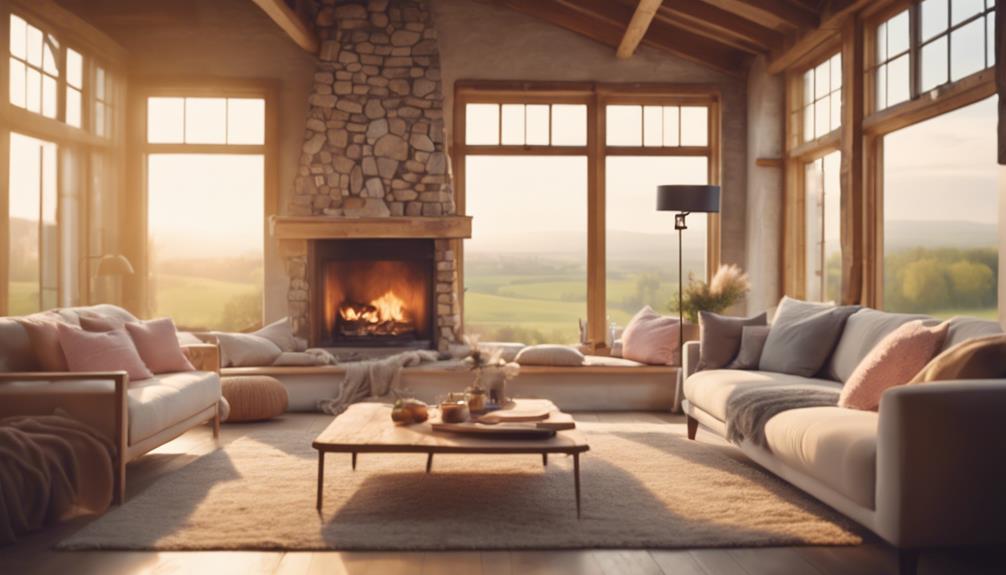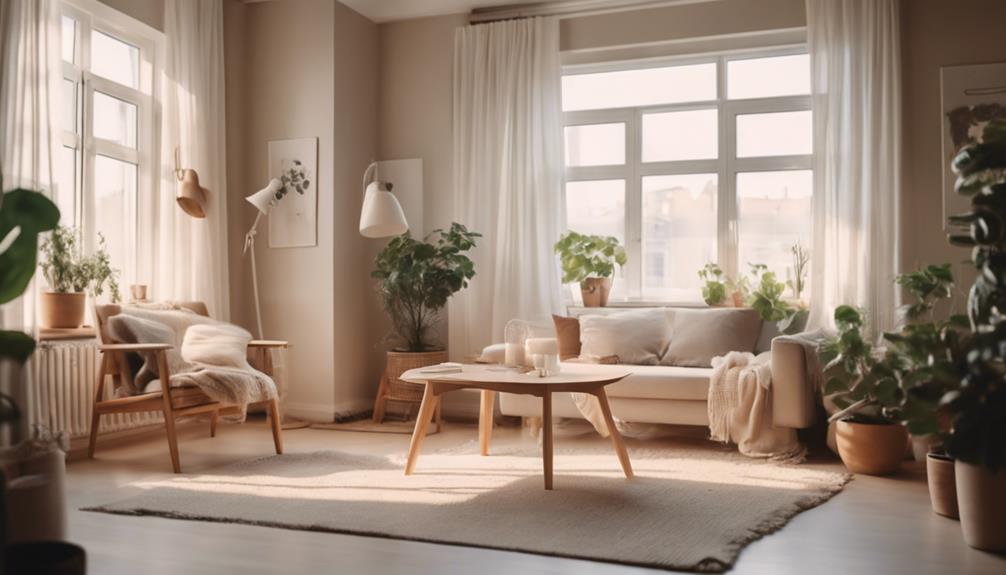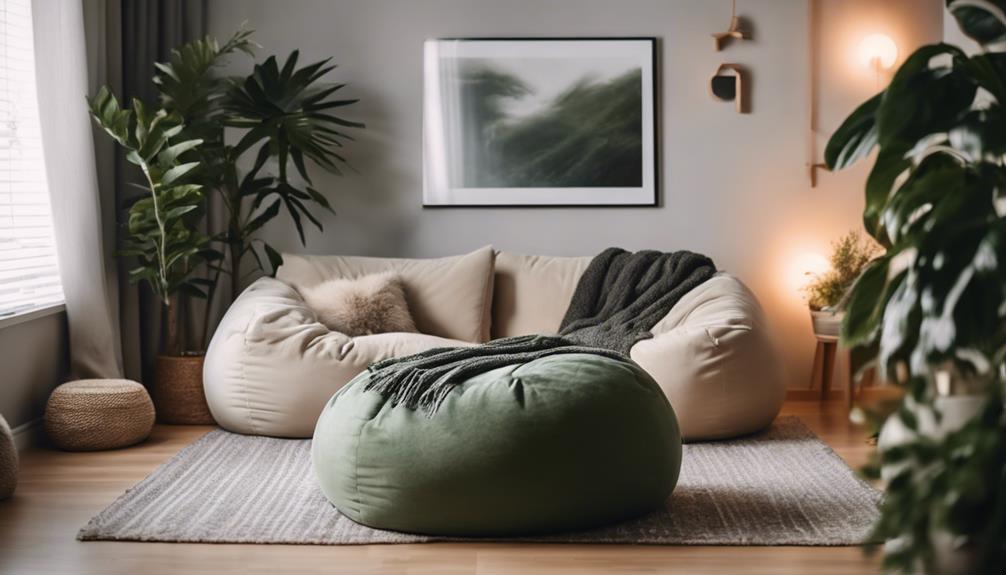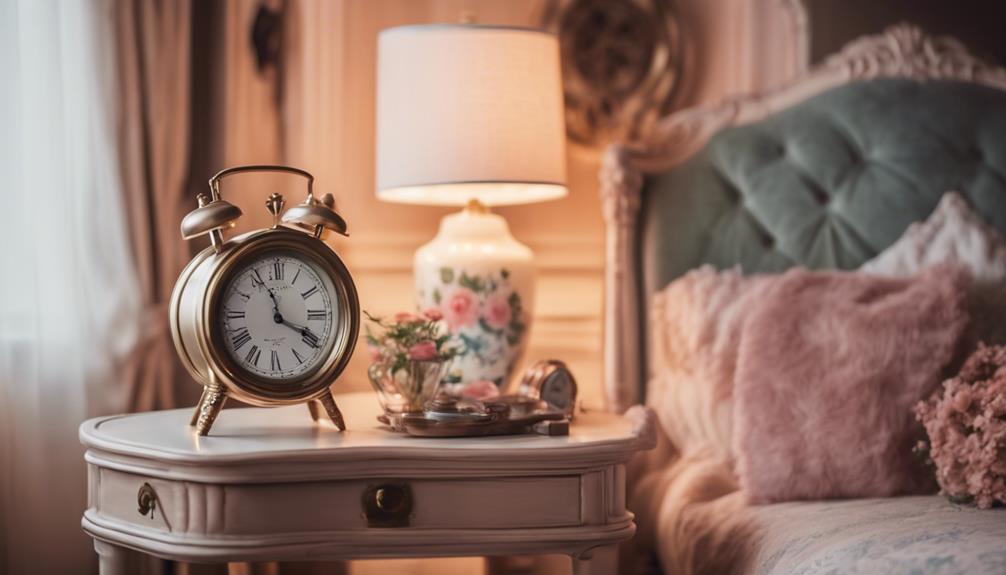You can effortlessly achieve country elegance in your home while maintaining the comfort of modern living. Start by using soft neutral colors like creams and grays to set a serene backdrop, accented with rich, vibrant hues. Incorporate natural materials such as reclaimed wood and plush textiles like velvet to enhance both aesthetic appeal and coziness. Vintage fixtures, like ornate brass lamps and rustic chandeliers, create inviting atmospheres. Add decorative touches like antique vases and nature-inspired prints to complete the look. This harmonious blend can transform your space beautifully, making it an inviting retreat. Explore more ideas to perfect your design. Consider adding a touch of modernity to your design with sleek and minimalist furniture pieces, maintaining a balance between traditional and contemporary elements. This minimalist country style transformation will bring a fresh and updated feel to your home while still paying homage to the charm of country elegance. Don’t be afraid to experiment with different textures, patterns, and finishes to create a unique and personalized space that reflects your individual style.
Key Elements
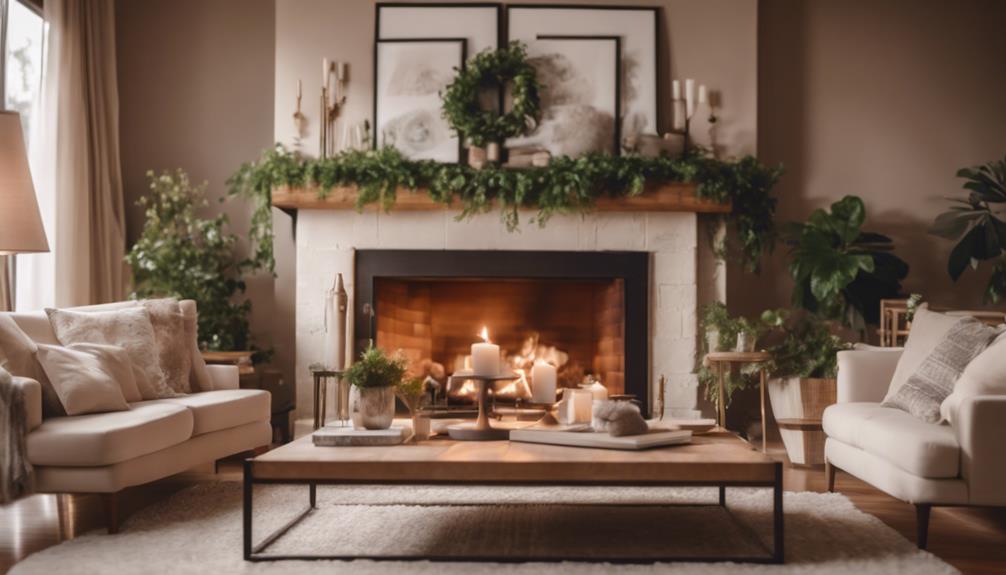
To create a perfect blend of country elegance and modern comfort, you'll want to focus on key elements like color scheme, materials, and textures.
Choosing a neutral palette sets the tone, while the right materials and textures can elevate the overall feel of your space.
Let's explore how these components work together to achieve that desired harmony.
Color Scheme
In creating a successful country elegance color scheme, soft neutrals like creams, grays, and whites serve as the serene backdrop for vibrant accents. These colors create a calm atmosphere, allowing you to introduce richer, earthy tones such as deep greens and warm browns. This approach not only evokes the natural beauty of the countryside but also maintains a modern aesthetic.
To enhance the space's comfort and style, consider textured layers through fabrics featuring floral, toile, or damask patterns. This adds depth and visual interest to your color scheme.
You can also incorporate muted pastel shades, which bring a revitalizing touch, striking a balance between rustic charm and contemporary elegance.
Materials
Natural materials like wood, stone, and marble effortlessly bring warmth and rustic charm to your space while keeping a modern aesthetic intact. In the spirit of French country style, these elements serve as foundational components that enhance your home's elegance. Choosing reclaimed wood for flooring or furniture pieces not only adds character but also tells a story, blending seamlessly with contemporary elements.
To elevate comfort, consider incorporating luxurious textiles like cotton, linen, and velvet. These fabrics provide softness and style, making your seating areas inviting while complementing the natural materials around them. You can also mix in vintage-inspired furnishings with curved lines and intricate carvings, which will add an inviting touch without sacrificing sophistication.
Creating a harmonious balance is key. Use a color palette of soft neutrals, such as creams and grays, paired with rich accent colors to tie everything together. This approach allows you to celebrate country elegance while enjoying modern comforts.
Textures
Incorporating a variety of textures throughout your space brings depth and visual interest, seamlessly blending country elegance with modern comfort. You can start by introducing soft linens and rustic woods, which create a warm and inviting atmosphere.
Layering textiles is key—consider velvet cushions paired with knitted throws to enhance coziness and add dimension.
Natural materials like stone and reclaimed wood are essential for conveying authenticity while maintaining a contemporary vibe. They embody the essence of country style without sacrificing modernity.
Additionally, don't shy away from mixing patterns; florals, stripes, and plaids can introduce a charming, eclectic feel that honors both rustic and modern sensibilities.
Textured wall finishes, such as shiplap or plaster, can infuse character into your rooms, achieving a clean and sophisticated look that aligns with modern design principles.
Remember, the goal is to create a harmonious balance of textures that evoke comfort and elegance.
Essential Fixtures and Furniture

When you choose essential fixtures and furniture for your space, consider pieces that blend elegance with comfort.
An antique wooden dining table paired with a vintage crystal chandelier can set the perfect tone, while rustic iron wall sconces add a charming touch.
These elements not only enhance the aesthetic but also create a welcoming atmosphere for gatherings.
Antique Wooden Dining Table
An antique wooden dining table not only serves as a stunning centerpiece but also brings warmth and character to your home, perfectly blending country elegance with modern comfort. These tables often feature beautiful craftsmanship, showcasing hand-carved details and unique grain patterns that make them true conversation pieces.
Imagine gathering your family around a table made from durable hardwoods like oak or walnut, designed to withstand daily use while enhancing the charm of your dining space.
You'll find that an antique wooden dining table can easily pair with various seating options, from upholstered chairs that add a touch of modern flair to rustic benches that evoke traditional charm. This versatility allows you to create a unique dining experience that reflects your personal style.
Incorporating an antique wooden dining table into your home promotes sustainability by reusing vintage furniture, while also embodying the essence of country elegance. With its rich history and aesthetic appeal, this table becomes more than just a piece of furniture; it transforms your dining area into a warm, inviting space where memories are made.
Embrace the blend of comfort and elegance with an antique wooden dining table that truly speaks to your heart.
Vintage Crystal Chandelier
A vintage crystal chandelier transforms your space into a stunning focal point, blending timeless elegance with rustic charm that enhances country-style interiors. By incorporating this striking fixture, you elevate the ambiance of any room, providing soft, diffused lighting that creates a warm and inviting atmosphere. The intricate designs and craftsmanship of a vintage crystal chandelier showcase the beauty of vintage materials, adding character to your modern spaces.
When selecting a vintage crystal chandelier, it's crucial to take into account the scale of the room. You want to verify it complements the space without overwhelming it, maintaining a balance between elegance and comfort. A well-chosen chandelier can tie together your design elements, drawing the eye and making your room feel more cohesive.
To keep your vintage crystal chandelier shining brightly, regular maintenance is key. This includes careful handling and cleaning to preserve its charm and guarantee it remains an eye-catching feature for years to come.
Rustic Iron Wall Sconces
Rustic iron wall sconces add a touch of charm and functionality, enhancing the elegance of your country-style decor while providing essential lighting.
These fixtures not only illuminate your space but also serve as artistic accents that elevate the overall aesthetic. Crafted from durable materials, rustic iron wall sconces are resilient against the elements, making them perfect for both indoor and outdoor use.
With intricate detailing and a vintage finish, these sconces bring character and warmth without overshadowing modern comfort. When you strategically place rustic iron wall sconces, you can create inviting ambiances that highlight architectural features or artwork, fostering a cozy, relaxed atmosphere.
Available in various styles and sizes, rustic iron wall sconces can seamlessly fit into different design schemes, from traditional farmhouse aesthetics to sleek contemporary interiors.
Whether you're looking to brighten up a hallway, living room, or outdoor patio, these sconces are versatile enough to meet your needs while maintaining that essential country elegance.
Lighting Ideas
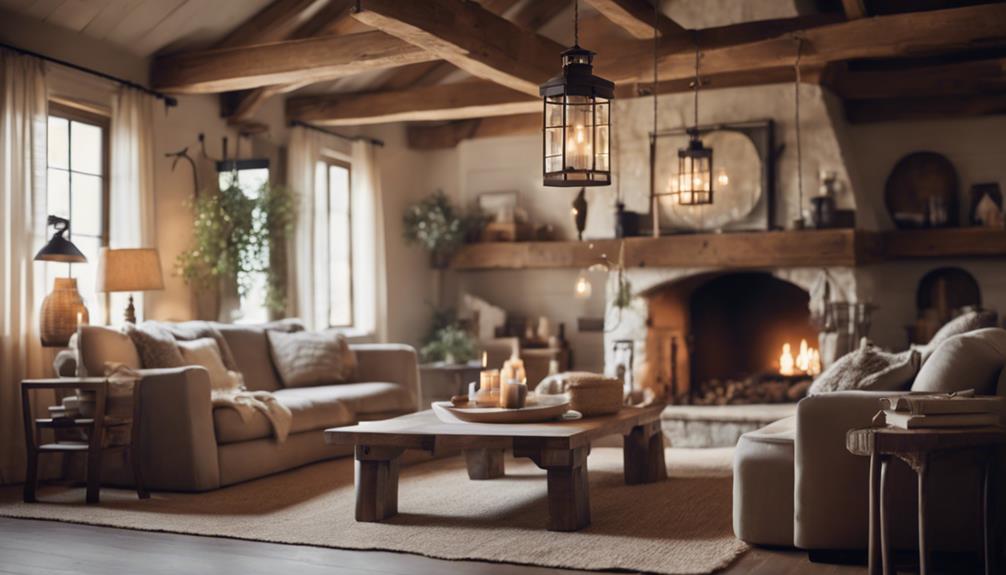
When it comes to lighting, you can easily blend country elegance with modern comfort.
Consider incorporating soft LED recessed lighting for a sleek look, or antique brass table lamps to add warmth and character.
Woven rattan pendant lights and vintage lantern string lights can further enhance your space, creating an inviting atmosphere that feels both stylish and cozy.
Soft LED Recessed Lighting
Soft LED recessed lighting transforms your space with a warm ambiance, perfectly blending country elegance with modern comfort.
In your living room, these fixtures create an inviting atmosphere that enhances the charm of a modern French country style. With their sleek design, recessed lights integrate seamlessly into your ceiling, maintaining clean lines that complement both rustic and contemporary decor.
One of the standout features of soft LED recessed lighting is its energy efficiency. Consuming up to 75% less energy than traditional incandescent bulbs, these lights not only lower your utility bills but also contribute to a more sustainable home environment.
Plus, their long lifespan of up to 50,000 hours means you'll spend less time replacing bulbs, fitting perfectly into a low-maintenance lifestyle.
You also have the flexibility to dim these lights, allowing you to easily shift from bright, functional lighting for daily activities to a softer, cozier glow ideal for relaxation or entertaining guests.
Antique Brass Table Lamps
Adding antique brass table lamps to your decor infuses a space with warmth and sophistication, perfectly complementing the soft LED recessed lighting you've already incorporated. The rich, golden hue of antique brass not only enhances the overall ambiance but also seamlessly blends with various color palettes and decor styles, making it a versatile choice for your home.
These lamps often showcase intricate designs, featuring ornate bases and patterned shades that serve as both functional lighting and decorative focal points. When you choose warm light bulbs, the glow from antique brass table lamps creates a cozy atmosphere, ideal for reading nooks or intimate dining areas.
Incorporating antique brass table lamps into your design scheme allows for a beautiful mix of old and new elements, reflecting a curated aesthetic that embodies the essence of country elegance. Whether you place them on a side table or a console, these lamps add character and charm, enhancing the country-style interiors you aspire to achieve.
Woven Rattan Pendant Lights
Woven rattan pendant lights bring a touch of natural elegance to your space, perfectly blending modern design with the warmth of country charm. These lights combine beautiful textures with contemporary flair, creating a warm and inviting ambiance that enhances your home's aesthetic. Lightweight and versatile, woven rattan pendant lights are ideal for various settings, from dining areas to living rooms, ensuring they won't overwhelm your decor.
One of the standout features of rattan is its sustainability, aligning seamlessly with today's emphasis on eco-friendliness. When you choose rattan, you're not just adding style; you're also making a responsible choice. Available in various shapes and sizes, these pendant lights allow you to customize your lighting to fit your room's dimensions and style perfectly.
Incorporating woven rattan pendant lights into your space creates visual interest with their intricate patterns and the enchanting shadows they cast. This contribution enhances a relaxed yet sophisticated atmosphere, making them a perfect fit for achieving that country elegance you desire without sacrificing modern comfort.
Vintage Lantern String Lights
Transform your outdoor space with vintage lantern string lights, as they effortlessly bring a warm, rustic charm that enhances your country elegance aesthetic.
These lights, reminiscent of vintage French designs, add character and coziness to any gathering. With styles ranging from classic Edison bulbs to creative mason jar designs, you can easily find the perfect fit for your decor.
Imagine illuminating your patio, porch, or garden with a soft, inviting glow that makes evenings more enjoyable. The versatility of vintage lantern string lights allows you to drape or hang them in various configurations, creating an enchanting atmosphere for friends and family.
Plus, with energy-efficient LED options available, you don't have to compromise on modern sustainability or worry about high electricity costs.
Installation is a breeze, making it simple to transform your outdoor area into a charming retreat. Whether you're hosting a dinner party or enjoying a quiet evening outside, these lights will elevate your space while keeping that country elegance vibe intact.
Embrace the blend of vintage allure and modern comfort by incorporating vintage lantern string lights into your outdoor decor today!
Decorative Elements
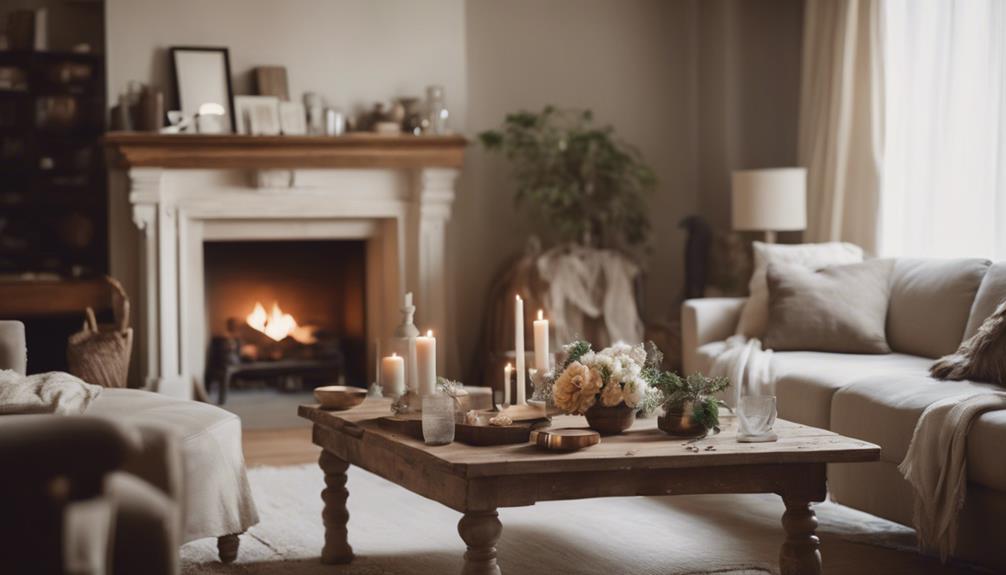
When you think about decorative elements that embody country elegance, consider incorporating an antique floral porcelain vase or a framed botanical art print.
These pieces not only enhance the room's charm but also create a harmonious blend with distressed wooden picture frames.
Antique Floral Porcelain Vase
Incorporating an antique floral porcelain vase into your decor instantly adds a striking focal point that blends vintage charm with modern elegance. These exquisite pieces often feature intricate hand-painted designs, showcasing the craftsmanship and artistry of their era. This attention to detail enhances your space's overall aesthetic, creating a unique conversation starter.
When you pair an antique floral porcelain vase with fresh or dried flowers, you create a harmonious blend of country elegance and contemporary style. The warm colors and delicate patterns of the vase elevate the natural beauty of the blooms, adding a touch of warmth to any setting.
Collecting antique porcelain vases can also be a valuable investment. Their rarity and historical significance may appreciate over time, making them not just a decorative element but a smart addition to your home.
Framed Botanical Art Print
Framed botanical art prints bring the beauty of nature indoors, enhancing your decor with a rejuvenating touch that captures the essence of country elegance. These prints, showcasing detailed illustrations or photographs of plants, create a relaxed and inviting atmosphere that aligns perfectly with your design vision. They serve as beautiful focal points, drawing the eye and adding a revitalizing element to any room.
Incorporating framed botanical art prints into your space is easy, as they complement various design schemes, from traditional to contemporary. You can select frames that enhance the artwork's style, opting for vintage or distressed finishes to reinforce that country charm while maintaining modern comfort.
Consider displaying a collection of framed botanical art prints to create a stunning gallery wall effect. This approach adds depth and interest to your space without overwhelming it. The versatility and beauty of these prints make them an ideal choice for anyone looking to achieve that perfect blend of country elegance and modern style.
With the right selection, you'll transform your home into a serene retreat that celebrates the natural world.
Distressed Wooden Picture Frame
Distressed wooden picture frames effortlessly infuse your space with rustic charm while enhancing the modern decor around them. These frames are a hallmark of country elegance, offering unique textures and finishes that bring warmth to any room. With their weathered paint or natural wood grain, distressed wooden picture frames create an inviting atmosphere that complements both traditional and contemporary artwork.
You'll find these frames available in various sizes and designs, making them versatile decorative elements for your home. By incorporating distressed frames, you can showcase cherished memories while maintaining a cohesive aesthetic. They provide a personal touch that elevates your decor without overwhelming it.
Additionally, distressed wooden picture frames are typically affordable and can be sourced from vintage shops, flea markets, or even crafted as DIY projects. This accessibility allows you to create a stylish yet comfortable environment that reflects your personality.
Flooring

When it comes to flooring, you can choose options like reclaimed oak wide plank flooring for a rustic yet elegant feel.
Hand-scraped maple hardwood offers a touch of sophistication, while distressed whitewashed pine adds a charming, laid-back vibe.
Each choice enhances the beauty of your space while ensuring comfort and durability.
Reclaimed Oak Wide Plank Flooring
Reclaimed oak wide plank flooring offers a sustainable and stylish solution that brings character and warmth to any modern space. If you're aiming for a French farmhouse aesthetic, this flooring choice is perfect. Sourced from salvaged wood, it not only promotes sustainability but also adds a rich history to your home. The wide plank design enhances visual appeal, creating an open and spacious feel while maintaining a rustic charm.
Known for its durability and strength, reclaimed oak flooring is ideal for high-traffic areas. You'll appreciate its warm and inviting look that complements both contemporary and traditional decor. Each plank features unique grain patterns and color variations, ensuring your flooring is one-of-a-kind and contributes to the overall country elegance of your home.
Install reclaimed oak wide plank flooring, and you'll find it effortlessly integrates into various design themes, enhancing your space's character. Whether you're decorating a cozy living room or a stylish kitchen, this flooring choice will elevate your design while keeping comfort at the forefront.
Embrace the beauty of reclaimed oak and transform your home into a welcoming haven that reflects both modern sensibilities and country charm.
Hand-scraped Maple Hardwood Flooring
Hand-scraped maple hardwood flooring brings a touch of rustic charm to your home while showcasing the natural beauty of the wood grain. This distinctive flooring option is crafted by manually distressing each plank, giving it a unique texture and character that enhances your space's appeal.
You'll love how every piece tells its own story, making your floors a focal point of warmth and style.
Maple is renowned for its durability and resistance to wear, making hand-scraped maple hardwood flooring perfect for high-traffic areas. It effortlessly combines a refined look with practicality, making it suitable for both modern and traditional settings.
Plus, you can personalize your flooring with various stains and sealants, from warm, honey tones to sleek, contemporary shades.
Beyond aesthetics, this flooring contributes to a cozy, inviting atmosphere, blending the charm of country living with the comfort you expect in a modern home.
Whether you're redesigning a room or building from scratch, hand-scraped maple hardwood flooring is an excellent choice that strikes the perfect balance between elegance and functionality.
Distressed Whitewashed Pine Flooring
Distressed whitewashed pine flooring instantly elevates your home with its rustic charm and modern aesthetic, perfectly blending comfort and style. This flooring option enhances the natural grain of the pine through a whitewashing technique, creating a light and airy feel that brightens any room. You'll love how it complements country elegance while seamlessly fitting into contemporary decor.
Highly durable, distressed whitewashed pine flooring is ideal for high-traffic areas, making it practical for your busy lifestyle. The distressed finish not only adds character but also helps mask scratches and wear, contributing to the effortless elegance of a lived-in space. Maintenance becomes a breeze, allowing you to enjoy your beautiful flooring without the constant worry.
Additionally, this versatile flooring pairs well with a range of design styles. Whether your home leans vintage or modern, distressed whitewashed pine flooring provides a cohesive look that ties your decor together. So, if you want to achieve that perfect blend of country charm and modern comfort, consider incorporating distressed whitewashed pine flooring into your living spaces. It's a choice that enhances both beauty and functionality.
Conclusion
By blending rustic charm with contemporary comfort, you can create a space that feels both inviting and stylish.
Focus on choosing essential fixtures that highlight your country aesthetic while incorporating modern furniture for functionality.
Don't forget to play with lighting and decorative elements to enhance the warmth of your home.
Finally, select flooring that complements your design while ensuring comfort.
With these tips, you can effortlessly achieve a perfect balance of country elegance and modern living.
